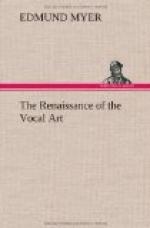A vowel sound is the result of an uninterrupted flow of the vibratory air current. A consonantal sound, on the other hand, is the result of a complete obstruction and explosion, of a partial obstruction and explosion, or of a partial obstruction only. The place and manner of the obstruction and explosion, or of the obstruction only, determine the character of the sound. There are three points of obstruction or articulation:
1. The point of contact of the base or back of the tongue and of the soft palate.
2. The contact of the tip of the tongue and of the hard palate, the roof of the mouth.
3. The contact of the lips, or of the lower lip and the teeth.
Almost any first-class work on the elements of the English language will give the divisions and the location of the consonantal sounds. For the singing voice it is always best to simplify, hence we divide the consonantal sounds into two general divisions: the aspirates, those which are the result of complete obstruction and explosion, or of partial obstruction only, breath and vowel sound; the sub-vocals, those which are the result of partial obstruction and explosion, or of partial obstruction only, sub-vocal and vowel sound. The sub-vocals, as ending or final consonants, are the most difficult of all to give their proper value and effect.
The student of the voice should study, understand, and practically train the action of these three points or places of articulation; for at these three points, with a few exceptions, all consonantal sounds are made. Take all the consonants, and classify them in two columns, the aspirates or breath sounds in one column, and the sub-vocals in another. We will give one example of each kind, as made at each point or place of articulation. By the aid of vowels we form syllables, and thus simplify the study, and make it more definite. The study of consonantal sounds without the use of vowel sounds is very indefinite and unsatisfactory.
We give the formula for the study of articulation, as found in “Exercises for the Training and Development of the Voice” (by the author of this work), on page 18.
Ko-Ok—Aspirate.
Thus: 1st Point.
Go-Og—Sub-vocal.
To-Ot—Aspirate.
2d
Point.
Do-Od—Sub-vocal.
Po-Op—Aspirate.
3d
Point.
Bo-Ob—Sub-vocal
Exaggerate the consonantal sounds in every instance, and the points of contact or places of articulation will be very evident. It will also be evident that the point of contact or articulation is much more positive on certain aspirates than on the sub-vocals; while on a few other aspirates the action or obstruction is so slight that it is almost impossible to tell where or how they are made. They are the exception to the general rule. To such, however, very little attention or study need be given. Having studied the formula as given, classify the consonants in three columns, under the headings of 1st, 2d, and 3d points or places of articulation.




